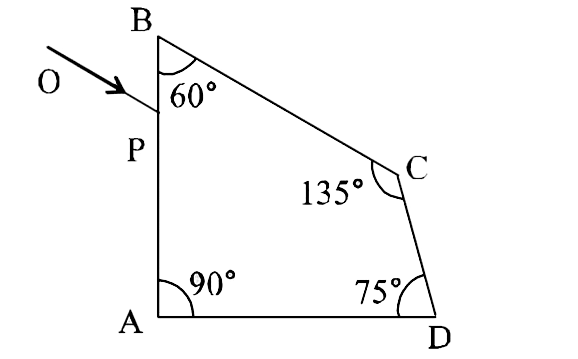A monochromatic light is incident at a certain angle on an equilateral triamgular prism and suffers minimum deviation . If the refractive index of the material of the prism is √3, them the angle of incidence is :
90∘
30∘
60∘
45∘
To solve the problem, we will follow these steps:
Step 1: Understand the Problem
We need to find the angle of incidence I for a monochromatic light incident on an equilateral triangular prism, which suffers minimum deviation. The refractive index n of the prism material is given as √3.
Step 2: Use the Formula for Minimum Deviation
For minimum deviation, the relationship between the angle of incidence I, the angle of the prism A, and the minimum deviation Dm is given by:
I=A+Dm2
Step 3: Identify the Angle of the Prism
Since it is an equilateral triangular prism, the angle A is:
A=60∘
Step 4: Use Snell's Law for Minimum Deviation
Using Snell's law, we have:
n=sin(A+Dm/2)sin(A/2)
Substituting the known values:
√3=sin(60∘+Dm/2)sin(30∘)
Step 5: Calculate sin(30∘)
We know:
sin(30∘)=12
Step 6: Substitute and Solve for Dm
Substituting into the equation:
√3=sin(60∘+Dm/2)1/2
This simplifies to:
√3⋅12=sin(60∘+Dm/2)
√32=sin(60∘+Dm/2)
Step 7: Find the Angle Corresponding to sin(60∘+Dm/2)
We know that:
sin(60∘)=√32
Thus, we can set:
60∘+Dm2=60∘
This implies:
Dm2=0⇒Dm=0
Step 8: Substitute Dm Back to Find I
Now substituting Dm back into the equation for I:
I=60∘+02=30∘
Step 9: Final Calculation
Since we need to find the angle of incidence when the deviation is minimum:
I=60∘+Dm2=60∘+30∘=60∘
Conclusion
Thus, the angle of incidence I is:
60∘
We need to find the angle of incidence I for a monochromatic light incident on an equilateral triangular prism, which suffers minimum deviation. The refractive index n of the prism material is given as √3.
For minimum deviation, the relationship between the angle of incidence I, the angle of the prism A, and the minimum deviation Dm is given by:
I=A+Dm2
Since it is an equilateral triangular prism, the angle A is:
A=60∘
Using Snell's law, we have:
n=sin(A+Dm/2)sin(A/2)
Substituting the known values:
√3=sin(60∘+Dm/2)sin(30∘)
We know:
sin(30∘)=12
Substituting into the equation:
√3=sin(60∘+Dm/2)1/2
This simplifies to:
√3⋅12=sin(60∘+Dm/2)
√32=sin(60∘+Dm/2)
We know that:
sin(60∘)=√32
Thus, we can set:
60∘+Dm2=60∘
This implies:
Dm2=0⇒Dm=0
Now substituting Dm back into the equation for I:
I=60∘+02=30∘
Since we need to find the angle of incidence when the deviation is minimum:
I=60∘+Dm2=60∘+30∘=60∘
Thus, the angle of incidence I is:
60∘
Topper's Solved these Questions
Similar Questions
The refractive index of the material of prism √3, then the angle of minimum deviation of prism is
View SolutionA ray of light incident at an angle 90° with the face of an equilateral prism passes symmetrically. Calculate the refractive index of the material of the prism
View SolutionThe refracting angle of the prism is 60∘ and the refractive index of the material of the prism is √3. Calculate the angle of minimum deviation in degree.
View SolutionWhen light rays are incident on a prism at an angle of 45∘, the minimum deviation is obtained. If refractive index of the material of prism is √2, then the angle of prism will be
View SolutionThe refracting angle of a prism is A, and refractive index of the material of the prism is cot(A2). The angle of minimum deviation is
View SolutionThe angle of minimum deviation from a prism is 37∘. If the angle of prism is 53∘, find the refractive index of the material of the prism.
View SolutionIf the angle of minimum deviation is of 60∘ for an equilateral prism , then the refractive index of the material of the prism is
View SolutionA ray OP of monochromatic light is incident on the face AB of prism ABCD mear vertex B at an incident angle of 60degree (see figure). If the refractive index of the material of the prism is √3, which of the following is (are) are correct?

View SolutionAn equilateral prism produces a minimum deviation of 30∘. The angle of incidence is
View SolutionA ray of monochromatic light is incident on one refracting face of a prism of angle 75∘. It passes thorugh the prism and is incident on the other face at the critical angle. If the refractive index of the material of the prism is √2, the angle of incidence on the first face of the prism is
View Solution
